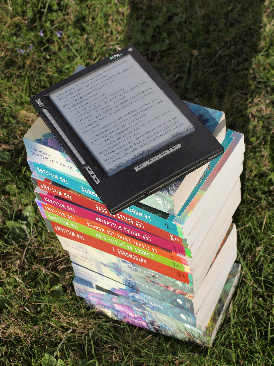Print is Dead, and Ebooks Rule - Right?
Biff Barnes
“Why are you still publishing print books?” a woman at the Tucson Festival of Books asked. “My friends tell me that everything is going to be digital.” That’s a legitimate question, so we had a friendly debate about the relative merits of digital and print books. As you know, at Stories To Tell we design both print and ebooks, but I don’t expect that print is dead or it will ever go out of style. Here are some reasons for a printed book:
 Photo courtesy of Wikipedia under Creative Commons
Photo courtesy of Wikipedia under Creative Commons
Genre fiction sells better, and nonfiction not so well, in e-book format.
Publishers Weekly regularly reports that fiction is the leading sales driver of ebooks. In this latest study, fiction accounted for 61% of unit sales, and 51% of revenue for ebooks. As for nonfiction, Sourcebooks found that Adult Nonfiction is 42.3% of the market for physical books, but accounts for less than 25% of e-books sold. Book Buzzr, in its post When Will the eBook Expressway Explode Sales for Nonfiction – as It Has for Fiction? said, “Exactly zero nonfiction authors have seen ebook sales that are comparable to the sales that these genre fiction authors have attracted.”
Illustrated books can be better formatted in print than is possible for an ebook.
There are several reasons books why photos, illustrations, and graphics work better in print:
- You can’t anticipate which ereader people have. The device controls the display of images. If someone is reading on an older version of the Kindle or on an iPhone they will not have the reader experience you intended.
- The resolution of images on paper is much higher, at least 300 dpi, than on e-readers where it is approximately 75 dpi. Screen height and width also limit the way images display.
- E-readers allow users to make text bigger or smaller. The tradeoff is that images and captions move when text size changes. You lose control of page layouts.
You want your book to be available to the entire book market.
The Book Industry Study Group most recent study of industry trends, Book Stats 2012, found that e-book sales had grown 45% since 2011, but they accounted for only 20% of the trade book market. Yes, ebooks are an increasingly important channel of distribution, but there’s another 80% of the market to consider.
There is not one single book market.
It is essential to ask what type of buyers you are targeting. What are their reasons for buying, where do they buy, and what are their book reading preferences? The publishing house Sourcebooks advised in a post E-Books: How Far How Fast? “The “book industry” is not just one industry; books are purchased by different types of users and for different reasons.”
Print is better if you care about preservation.
If you are creating a book to pass down through the generations, print is more lasting than data, which can be easily corrupted or erased. The Library of Congress says you should still consider paper the “archival medium.” Think about the rapid emergence and disappearance of storage technologies over the past twenty-five years, such as BetaMax and floppy disks, which cannot be read today. It is likely that ebooks will evolve into a variety of new formats too, and that some data may be lost in the process.
Print books sell better in person.
Speakers and consultants who sell their books directly at events know that people will buy print over a digital version. A tangible book that can be examined is more effective than offering the same material on CD or as a download. For these authors it is good to have both an e-book version available for download from their website and ebookstores, in addition to a print version for direct sales.
What do you think? Leave a comment about how you intend to publish, Do you prefer one format or the other, print or ebook?